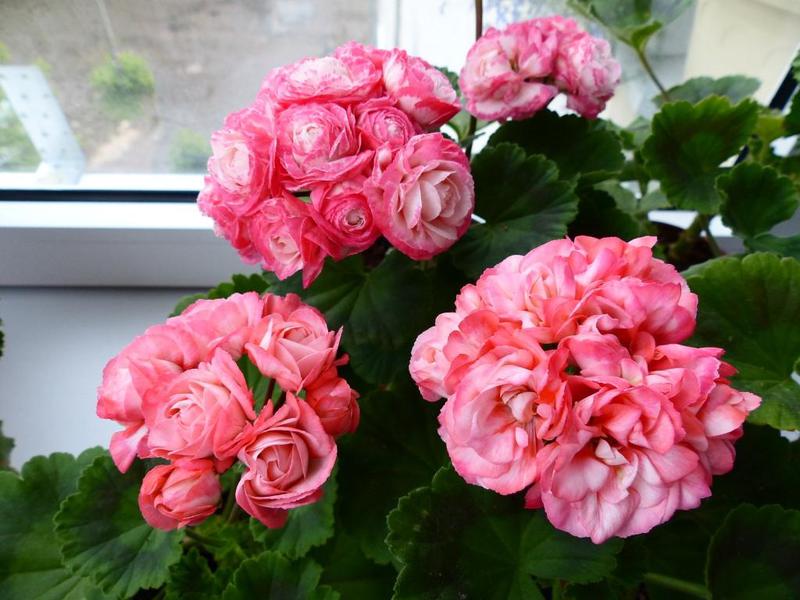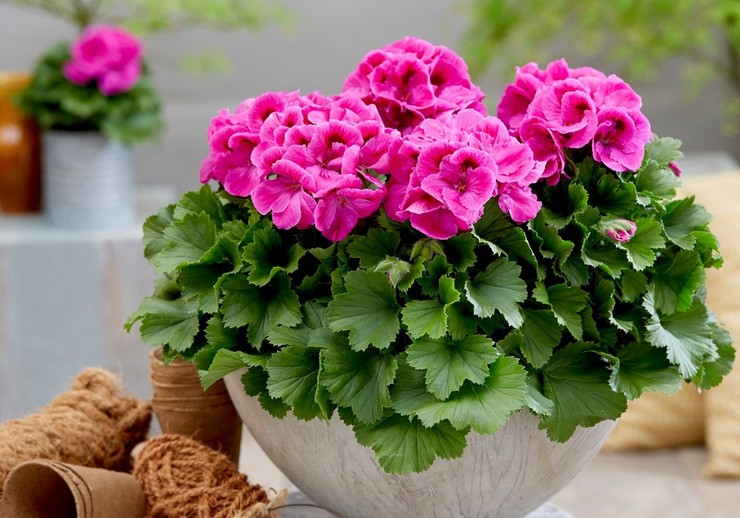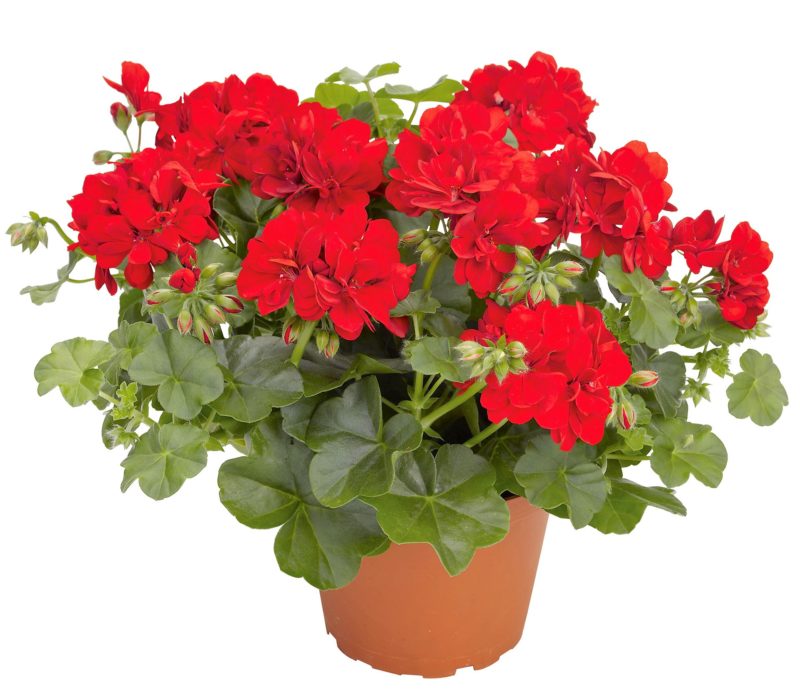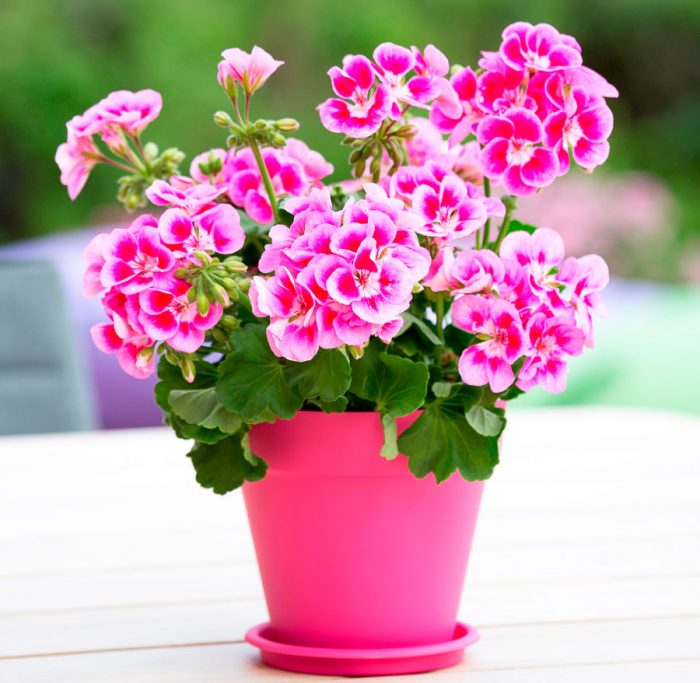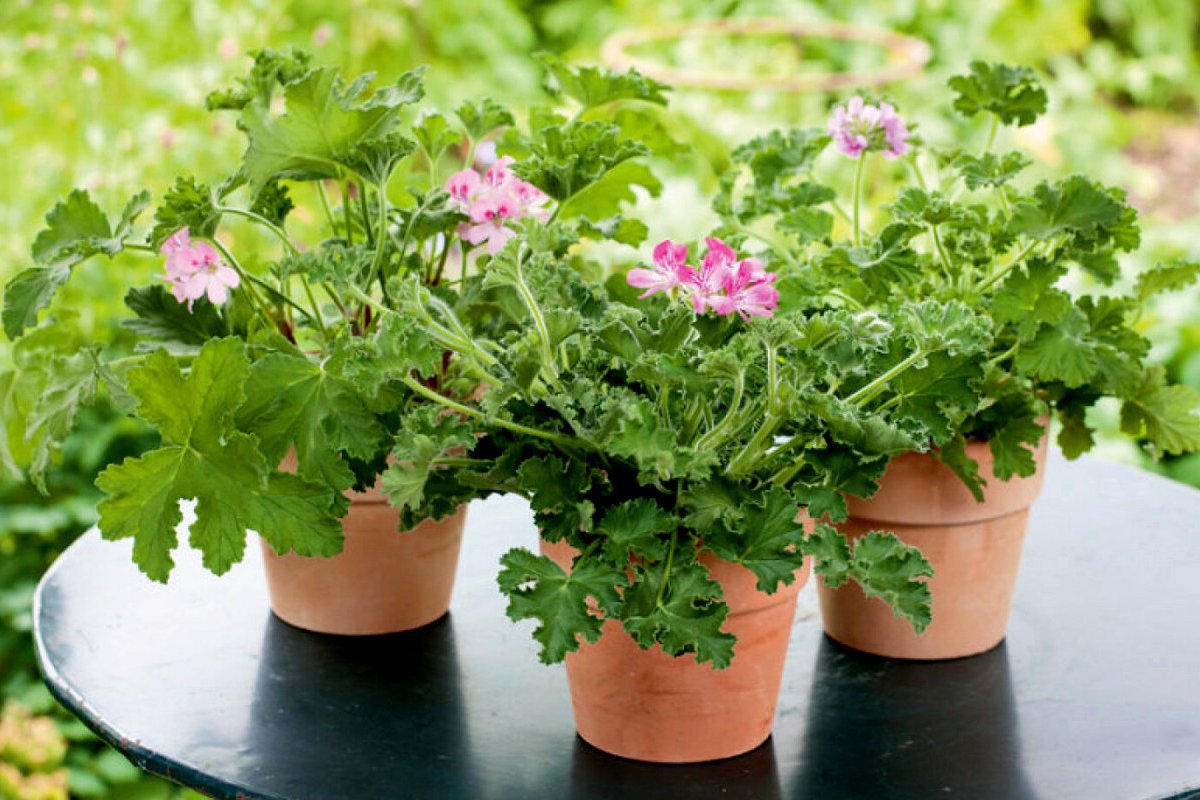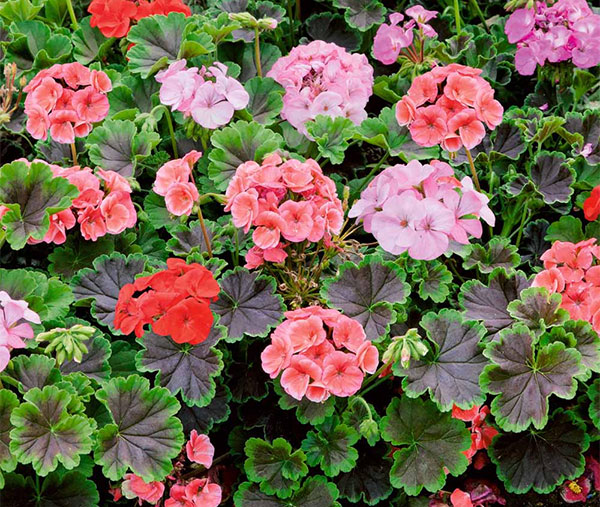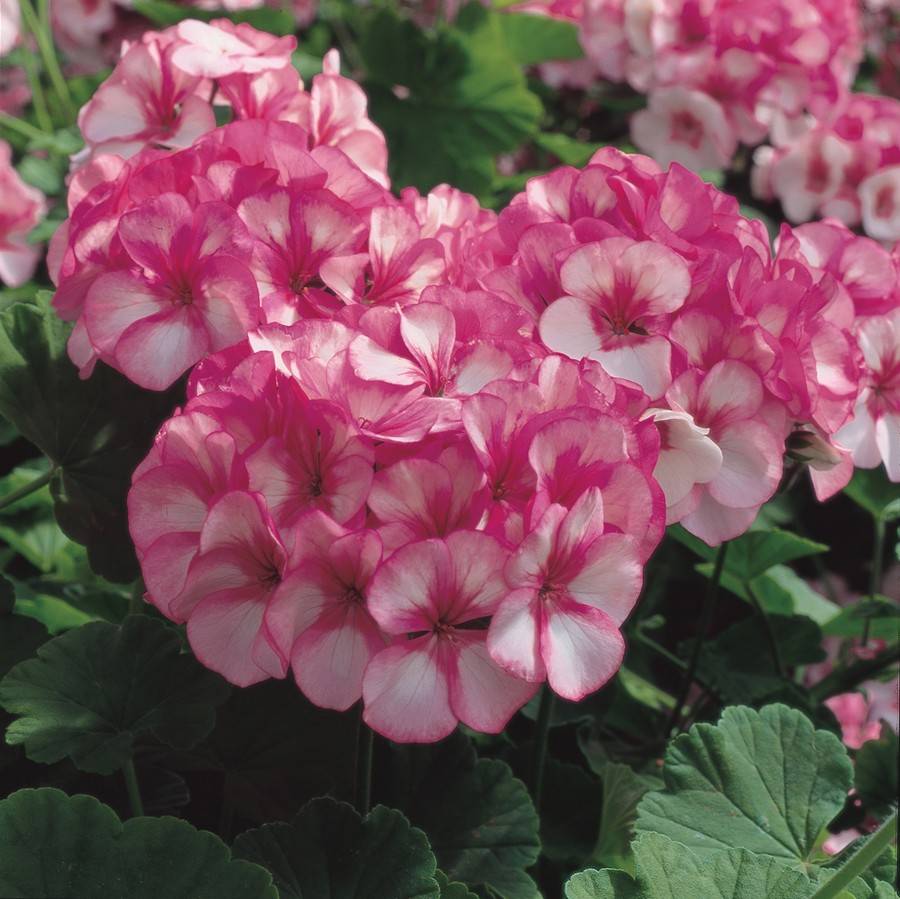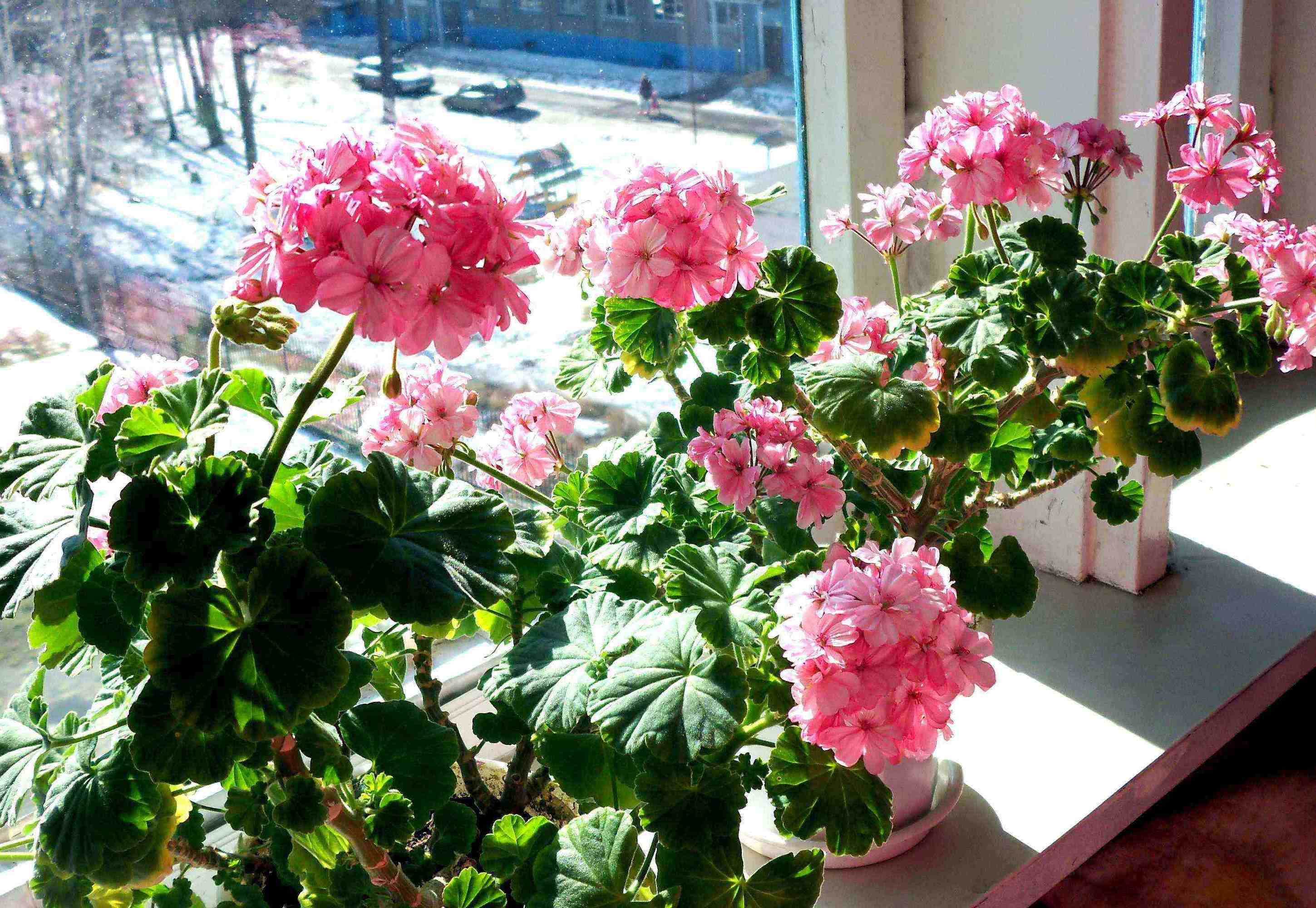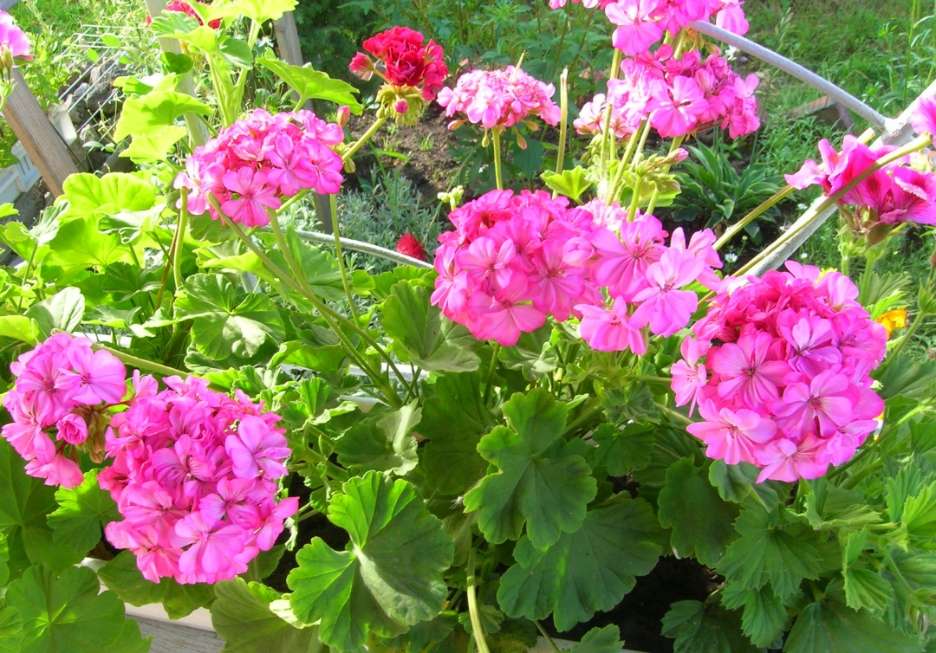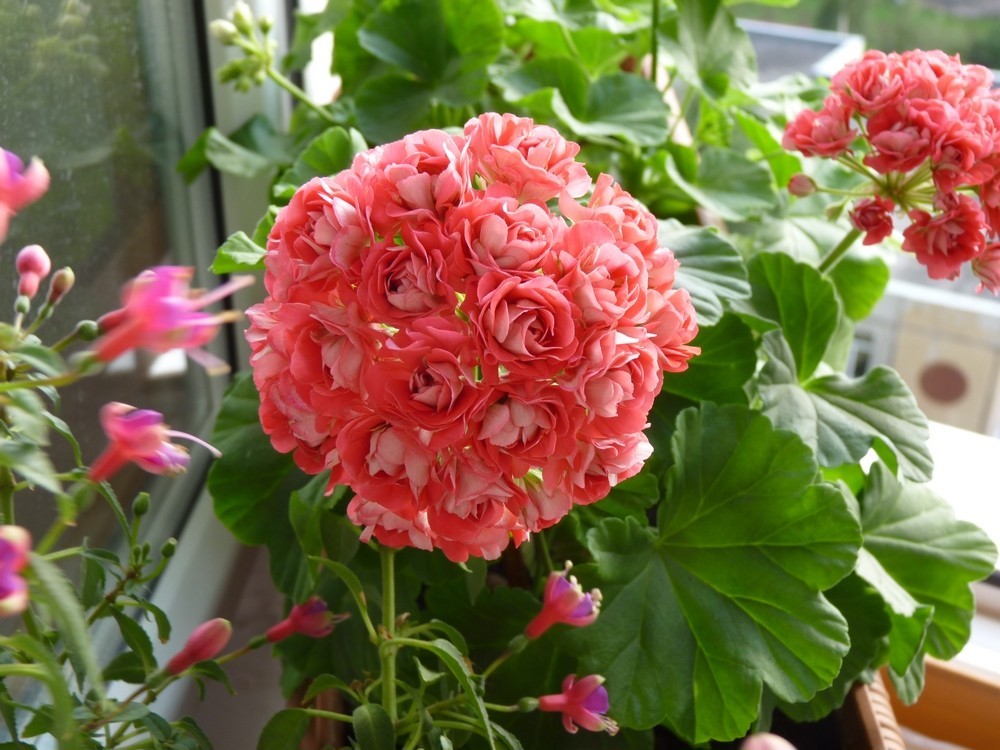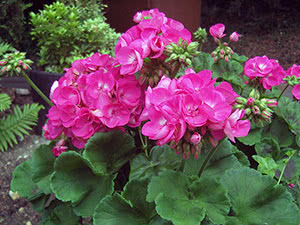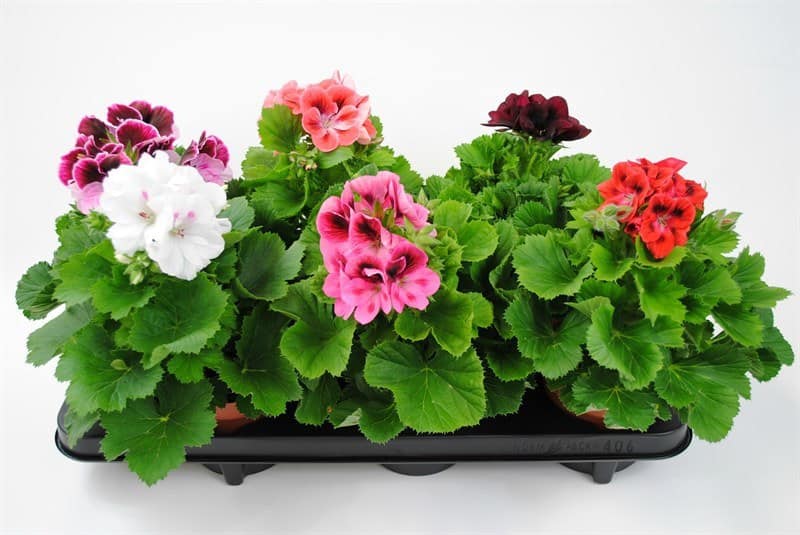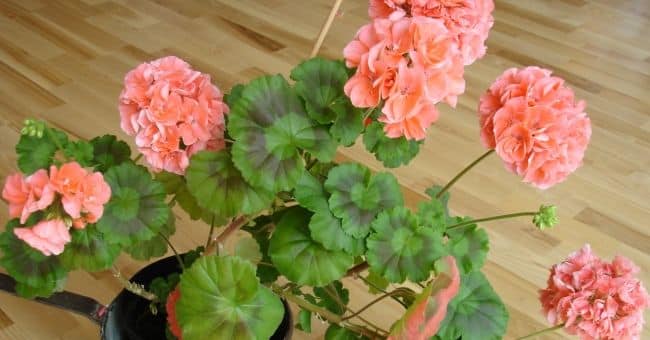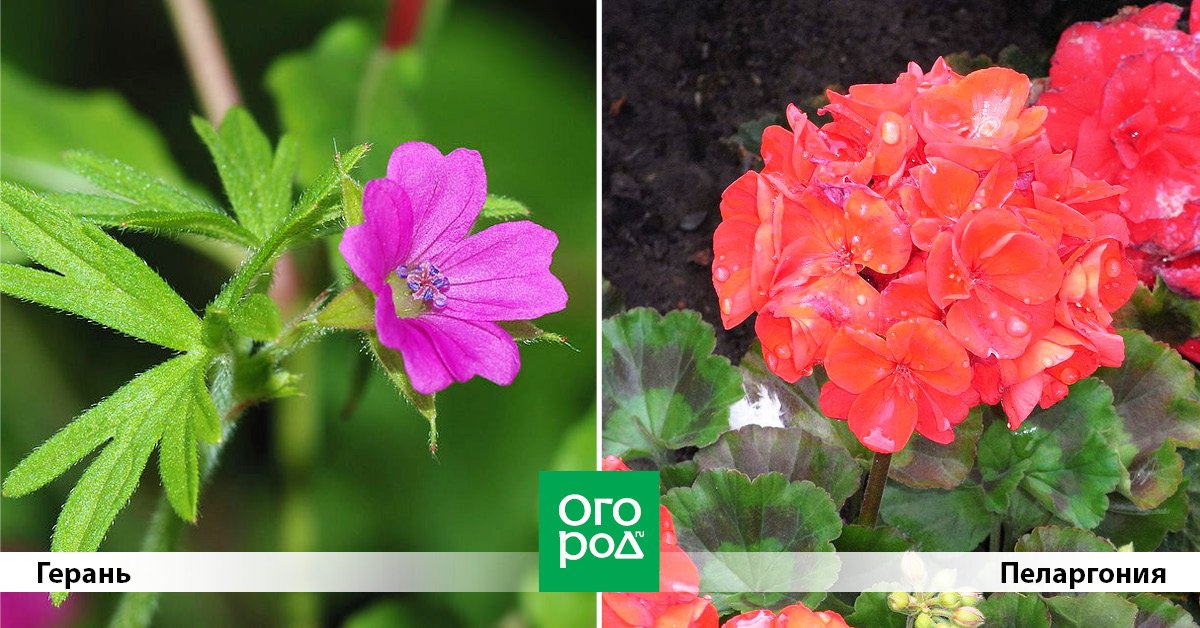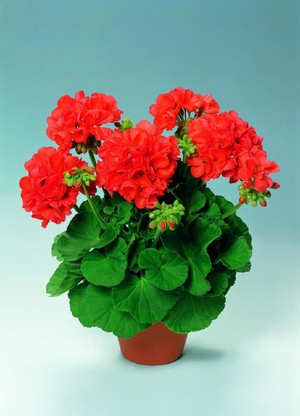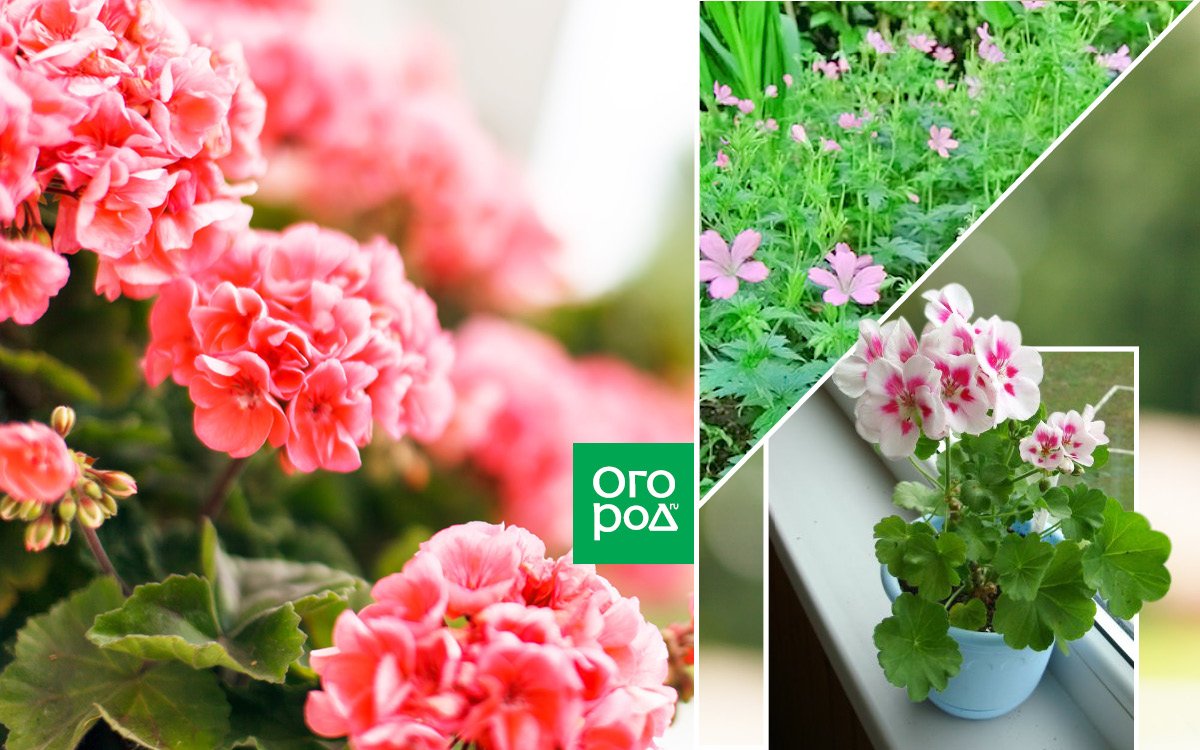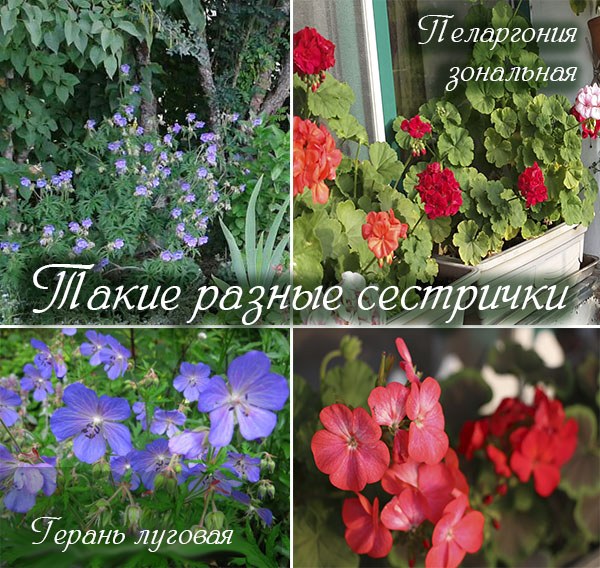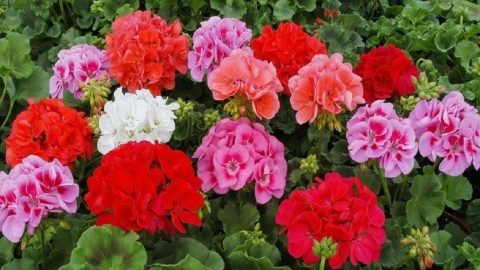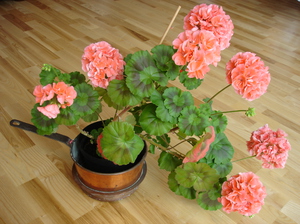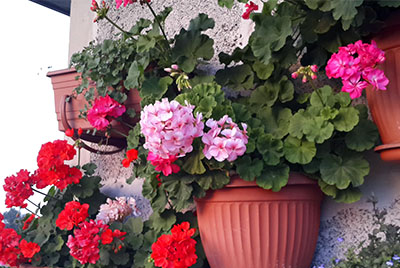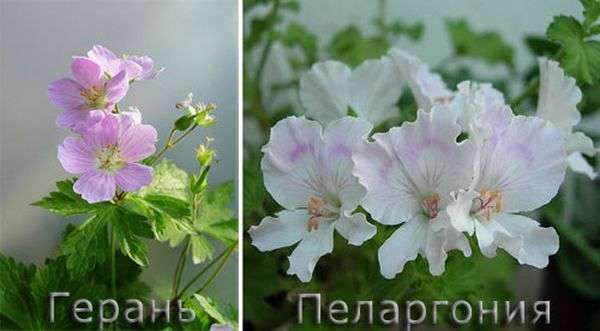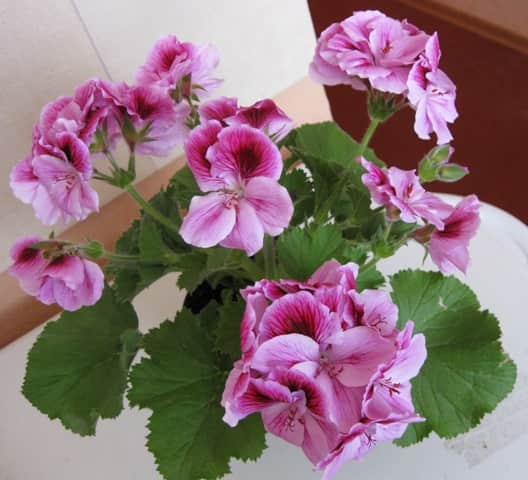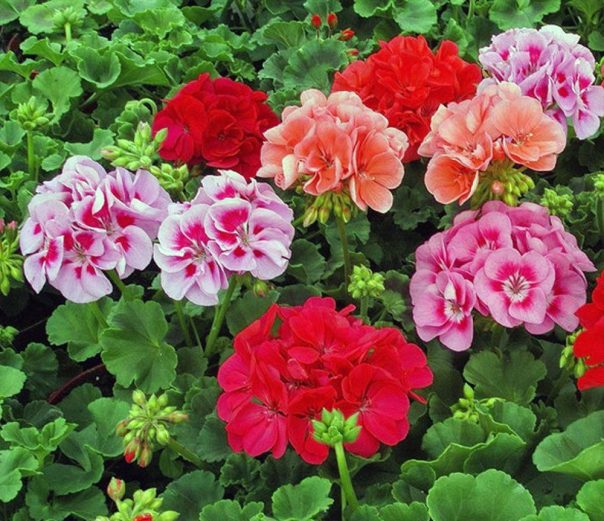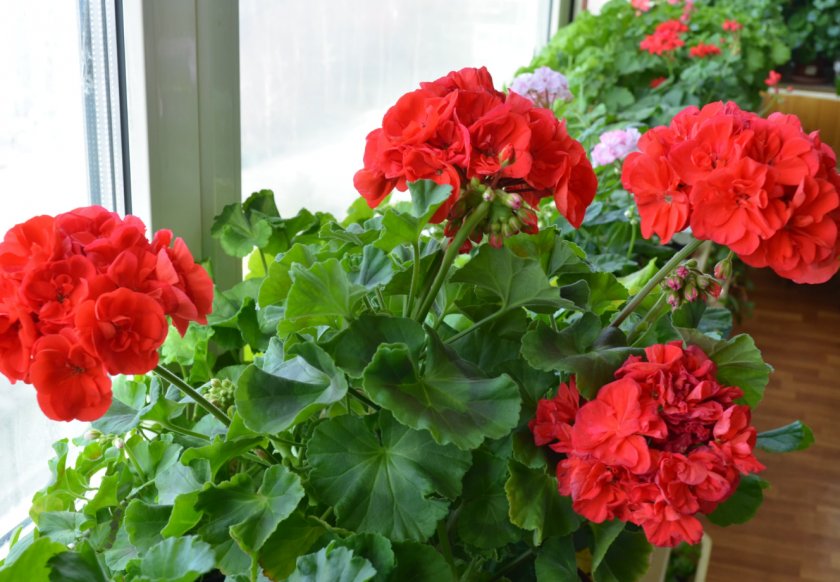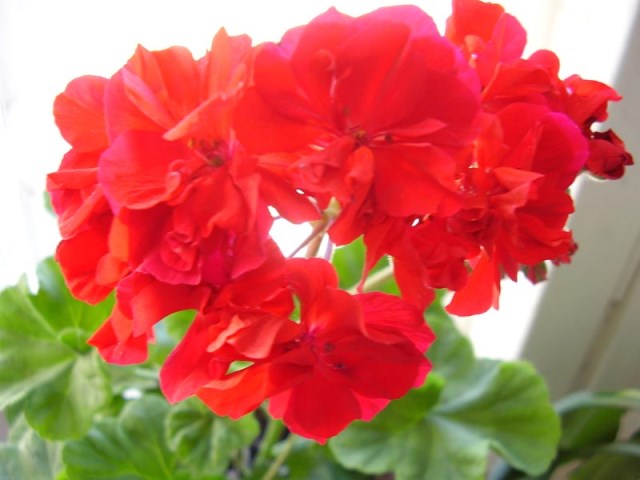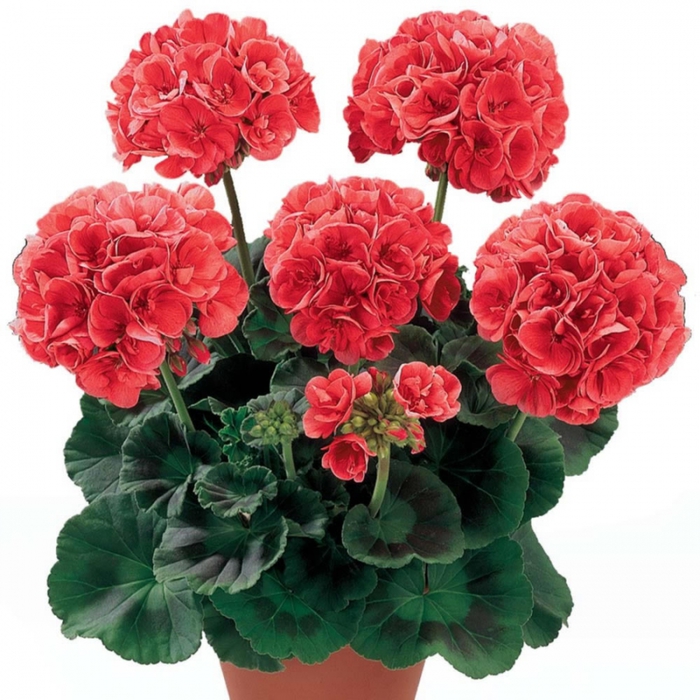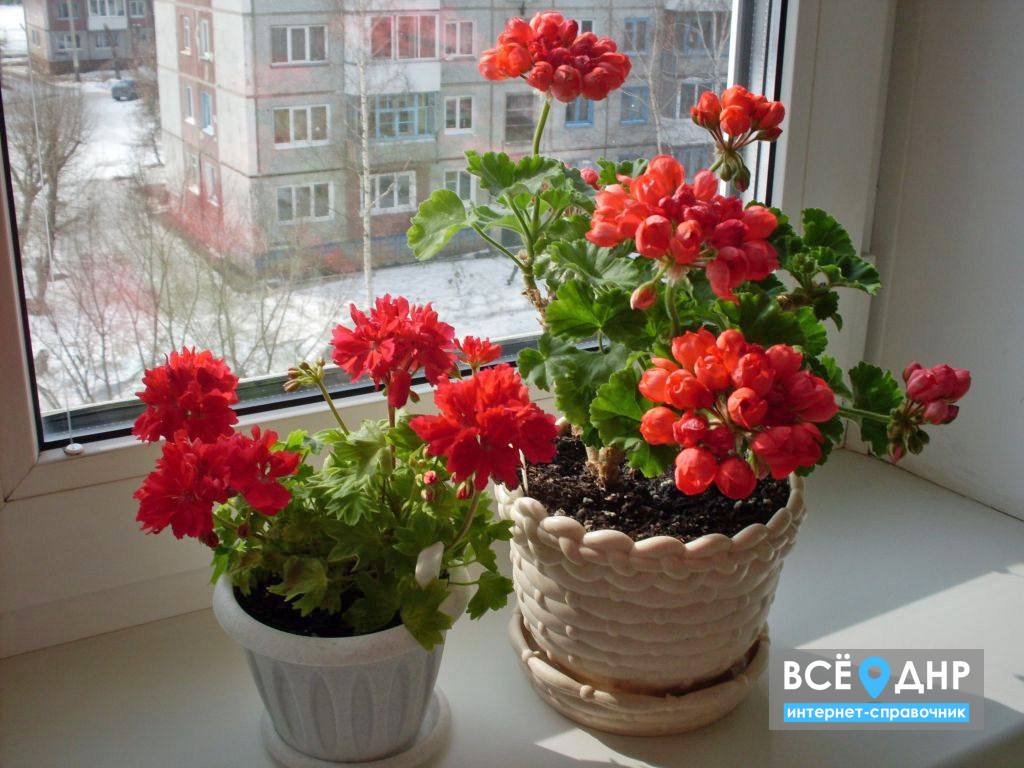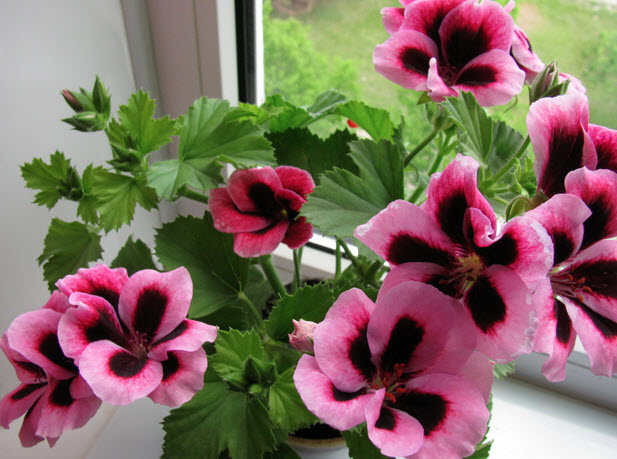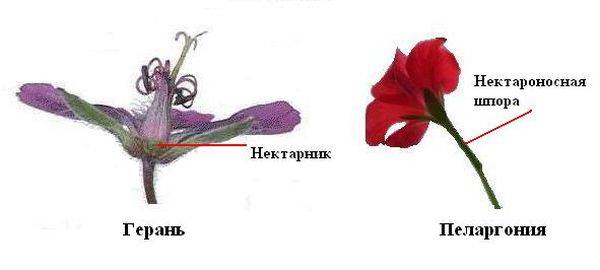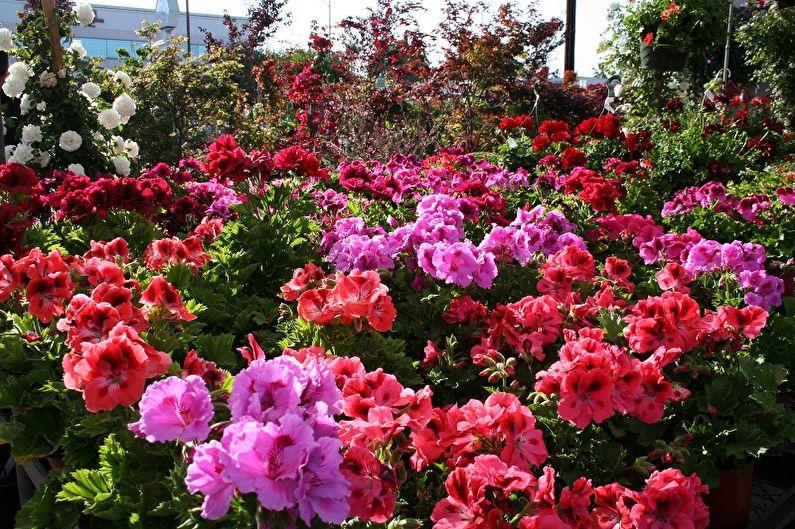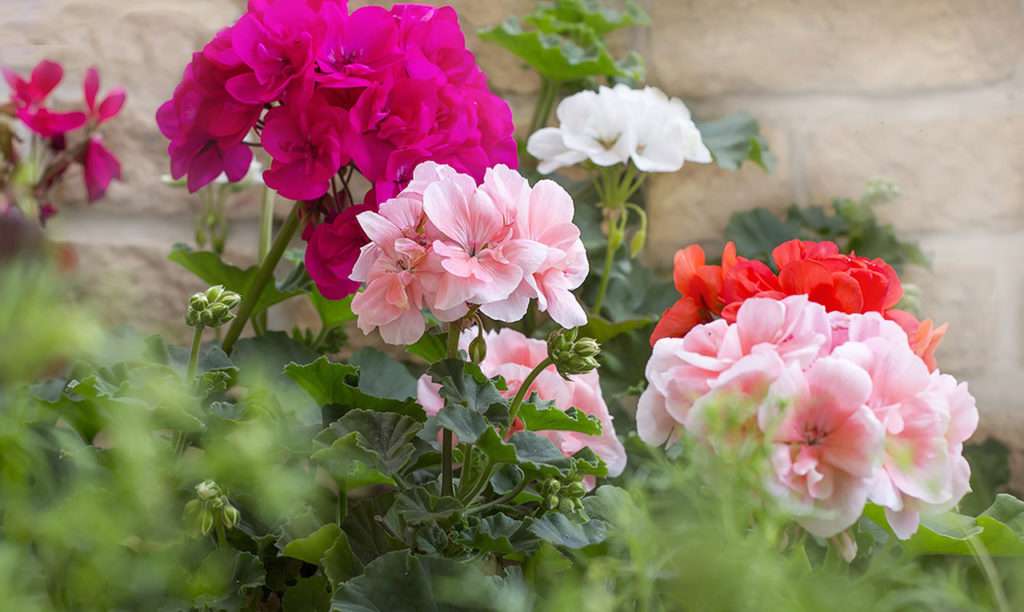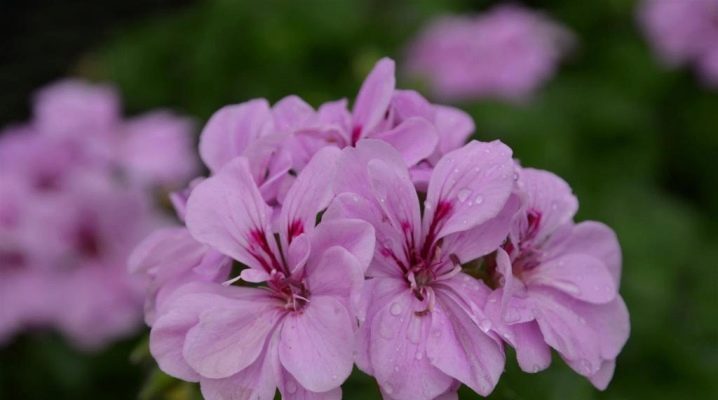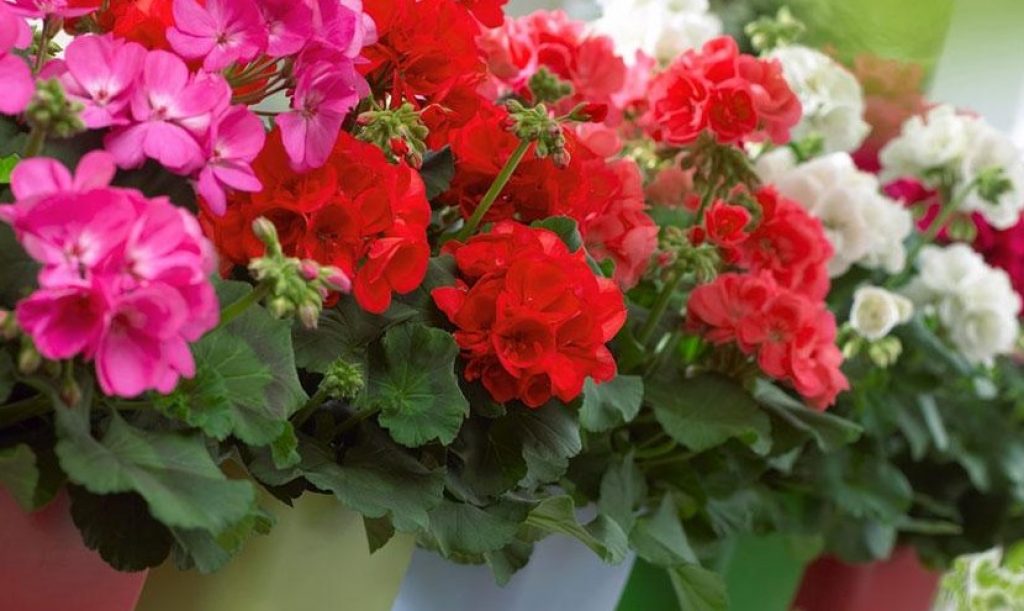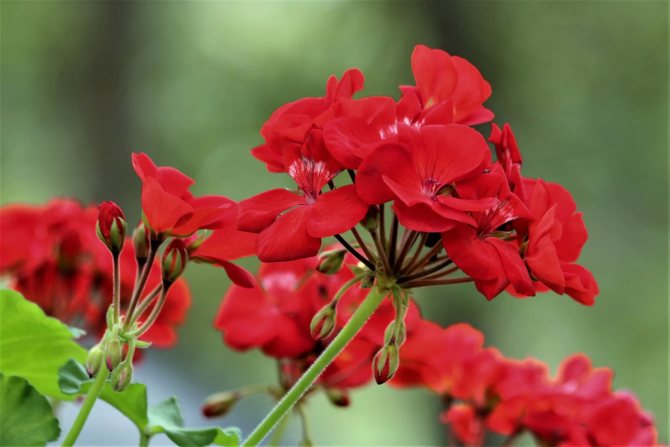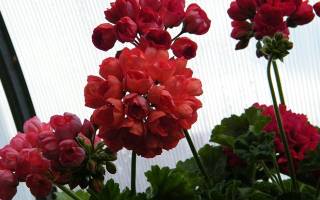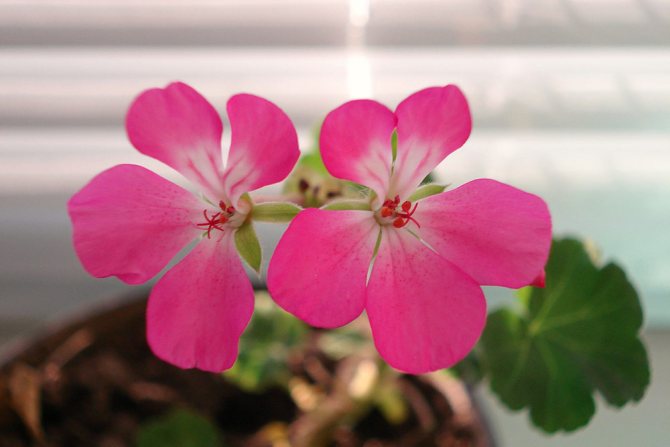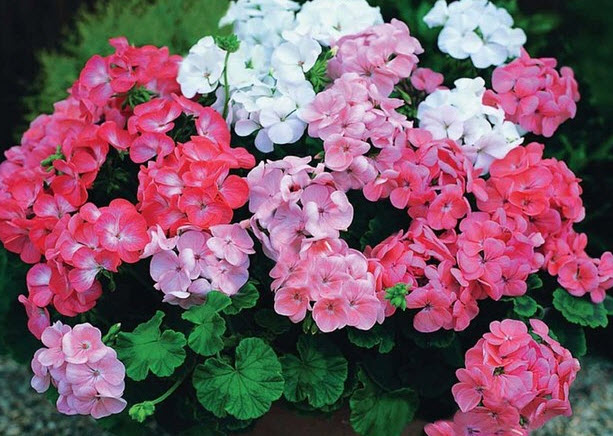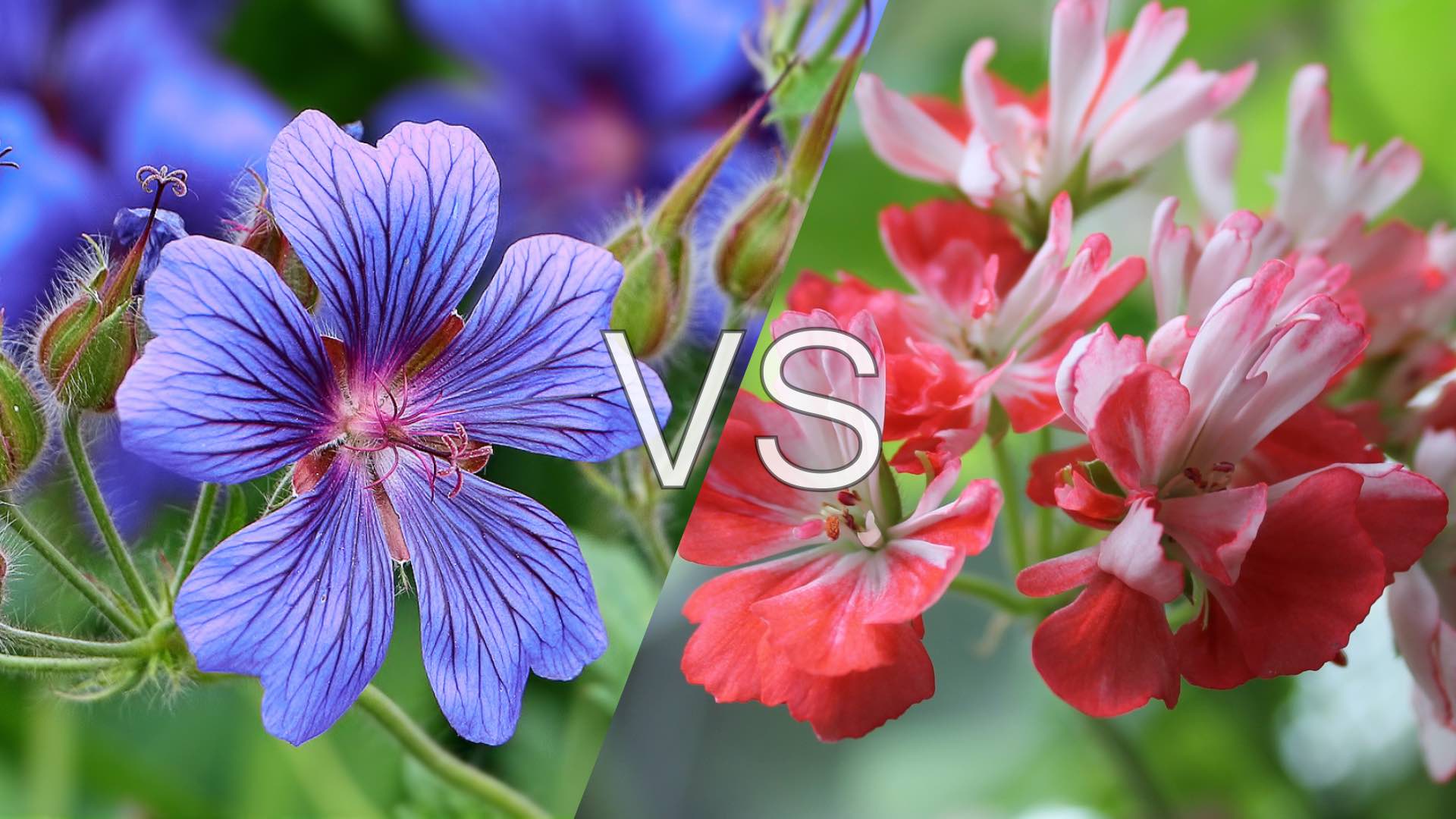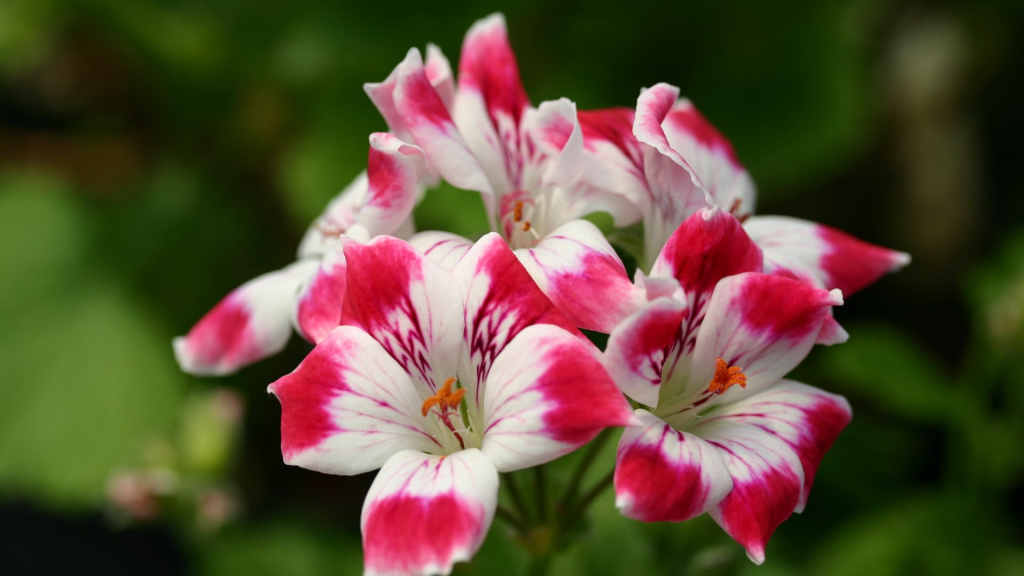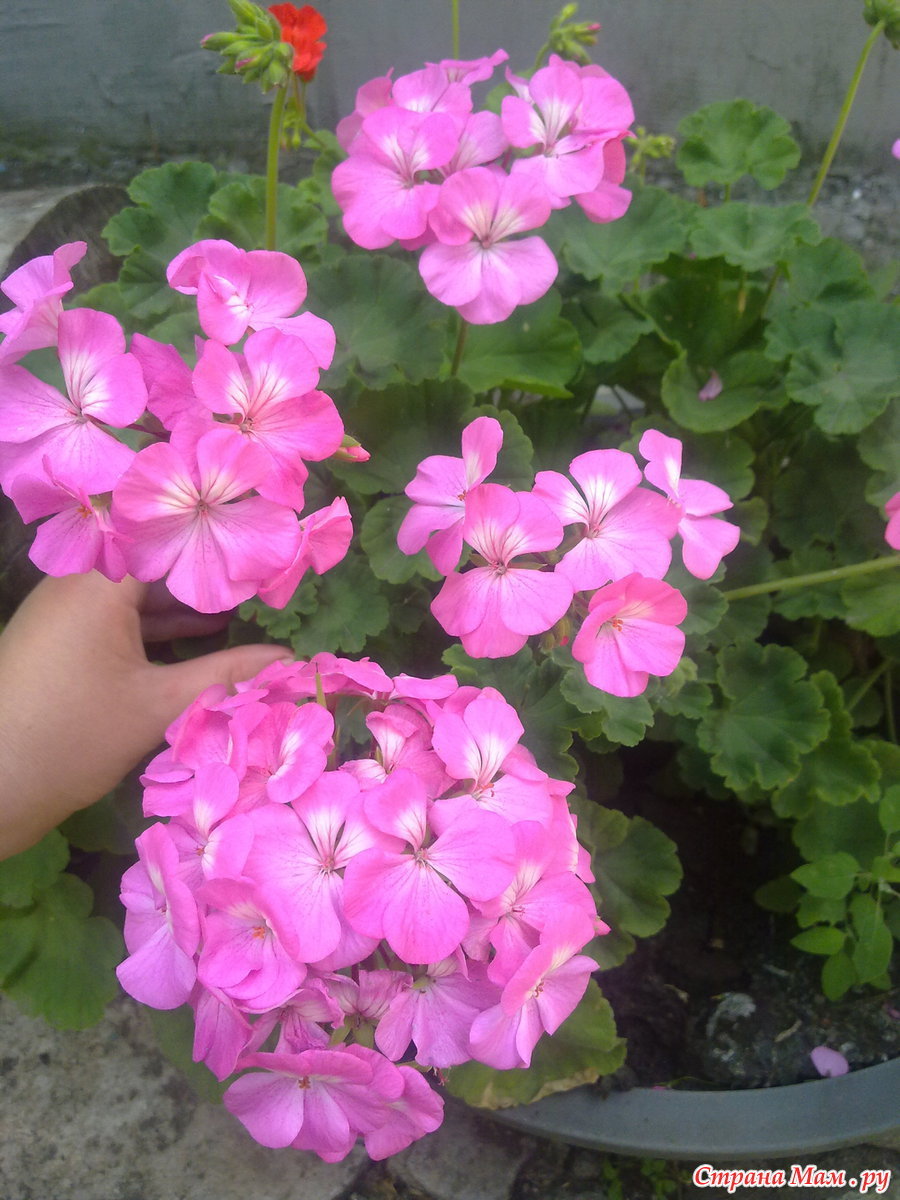Beneficial features
The aroma of pelargonium helps to get rid of the depressive state. The plant helps in cleaning the air in the room from germs. Its leaves can be applied to wounds as a hemostatic and healing agent.
Pelargonium oil is especially popular for the treatment of diseases and cosmetic procedures. It is used to treat infectious diseases of the ears and nose, relieves back pain, headaches or toothaches, and has a good effect on the nervous system. The extract from the root of saddle-shaped pelargonium, for example, is a part of "Umkalor", which effectively helps in diseases of the respiratory tract and ENT organs. The bactericidal, antiseptic and soothing properties of the oil are used in care products for oily, inflammation-prone skin.
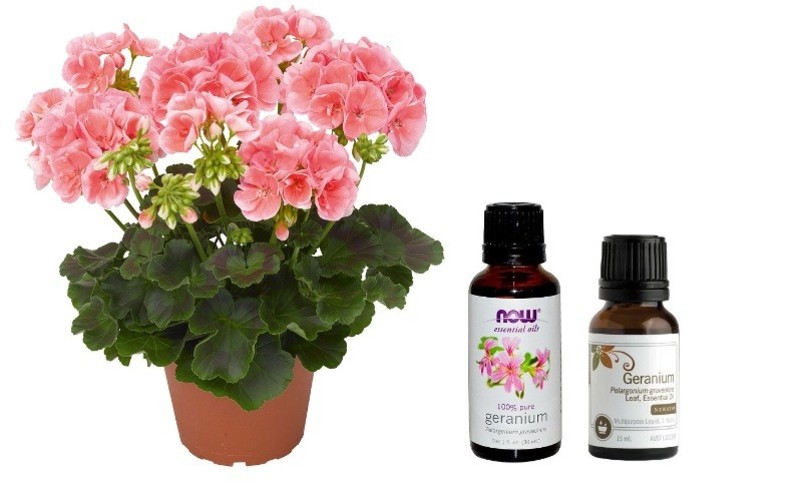
Pelargonium-based preparations are forbidden to be taken by people suffering from gastric ulcer, thrombophlebitis, frequent constipation, as well as women during pregnancy.
Geranium care
Geranium is an unpretentious flower, and if the gardener does not have the opportunity to devote much time to flowering plants, then this is what you need. You can quite safely skip the planned pruning or feeding or not cover for the winter - the plant will not be offended. It will still bloom and smell.
Planting is best done in early spring or fall. The hole for the geranium should be larger than the length of the seedling. You need to deepen the root by 5 cm. After that, it is necessary to use mulch and ensure regular watering. If several bushes are being planted, then it must be borne in mind that the plants are growing and it is necessary to leave a distance of 30 cm between them.
Watering should be moderate and regular. Drought should be avoided. This will have a negative effect on flowering, and the leaves may dry out. Heavy watering can also affect flowering. It can stop altogether.
Geranium in the garden benefits from attracting pollinators and repelling harmful insects.
With this in mind, it is allowed to plant it directly on the beds. After the flowering period has ended, you need to remove the peduncles. And in the fall, cut off the faded aerial part.
Geranium has a sufficient range of varieties that are planted in the garden. There are red geraniums, brown and ash. Propagating them by seeds is quite laborious, so it is better to do this by seedlings or by dividing the bush.

Botanical definition
Geranium
Geranium is a genus of annual or perennial plants that are grown for ornamental purposes. The name is translated from Greek as crane. The plant grows well in temperate climates and winters outdoors. Geranium reaches a height of 60 cm.
These flowers are planted in small groups, given that they grow in a short time.
The plant has a strong, branched root system. Thanks to this, geranium does not need constant feeding. The leaves of this genus have a long stalk and a finger-like shape.
The flowers have the correct shape. They are bisexual and have 5 or 8 symmetrical rounded petals, as well as 10 stamens. The inflorescence can be either single or part of an umbrella. The color of the plant can be:
- raspberry;
- lilac;
- blue;
- white.
Geranium is considered the most popular plant. There are a wide variety of varieties and species. Read about the peculiarities of growing this flower on our website.
Pelargonium
Pelargonium is a houseplant. In summer, flower pots can be displayed on the balcony and outside verandas. The plant is light-loving, but does not tolerate direct sunlight.
Also, this flower is sensitive to watering, so it is important to carefully approach this process.
Pelargonium has large umbellate inflorescences with irregularly shaped flowers: its two upper petals are larger than the lower ones. Petals can be:
- white;
- pink;
- dark red.
There are bicolor varieties that have spots or contrasting strokes, but there are no varieties of this plant with blue or purple petals.
Each flower has 7 fertile stamens, the rest are usually underdeveloped.
The plant has a large fibrous root, so in warm weather it needs to be actively watered and fed.
Reproduction methods of perennial geranium
Breeding garden geraniums is easy enough. To do this, you need to choose one of the methods described below. The plant propagates by seeds, cuttings or bush division. In favorable conditions, geraniums can multiply by self-seeding.
The only drawback of such a breeding may be the randomness of these landings. However, you can plant the sprouts as you see fit.
Seed propagation
Perennial garden geranium, planting and care, which does not require a lot of effort, can multiply by seeds. The pros and cons of the process are as follows:
- This method is rather laborious and time-consuming. Very often, hybrid plants lose their distinctive characteristics with this cultivation. But breeders most often develop new varieties from seeds.
- For sowing, only fresh seeds are needed, since the germination capacity of the material decreases during long-term storage.
- Harvesting the seeds of the plant is very difficult, because as soon as they are ripe, they immediately become volatile. Unripe seeds germinate very poorly. To simplify your task, you can wrap several inflorescences with a cloth so that the seeds remain on it after ripening.
- Sowing is carried out directly into the open ground. This is done in late summer or early autumn. Store seeds are best sown in early spring in special containers like ordinary seedlings.
- For sowing, you will need a soil mixture of peat and sand, pre-well moistened. - Seeds are scattered over the soil surface and the container is covered with glass.
- In the future, it is necessary to periodically ventilate and moisten the container before the emergence of shoots. - As soon as the first leaves appear, the glass is removed.
- The pick occurs in the phase of two true pairs of leaves.
- Seedlings are planted in the ground only the next year.
Propagation by parts of the rhizome
This method is considered the most efficient and fastest. It allows you to update the landing quickly enough.
The process is as follows:
- Division is carried out in early spring or August when the plants are dormant.
- After the flower is dug up, you need to inspect the condition of the buds on the rhizome. It is from them that young shoots will develop. There should be no rot or other defects on the root.
- Then you need to carefully divide the rhizome into parts with a sharp knife. Each piece must have a living kidney.
- First you need to prepare the landing sites. Peat and compost are placed at the bottom of each hole.
- The root is placed in the hole and covered with earth.
Propagation by cuttings
This type of propagation is suitable for some varieties of perennial geraniums. To do this, you need to cut off several young shoots with leaves from a healthy plant.
- The cuttings are placed in a container of water and placed in a well-lit, warm place.
- Roots usually appear after two or three weeks.
- They can then be planted in prepared pots or open ground.
- To speed up the process, you can process the blanks with a root former.
Reproduction of pelargonium
The main breeding method for all pelargoniums is cuttings. Plants are mainly represented by hybrid varieties, in which the characteristics are not preserved during seed propagation.Despite the fact that pelargoniums are widely represented in the catalogs of seeds of ornamental plants, and from the point of view of the speed of obtaining full-fledged flowering bushes, cuttings remain preferable.
Pelargonium cuttings are cut from semi-lignified non-flowering shoots, traditionally - at the end of summer, in August or September, if possible, cutting them off from the heel. Sections must be dried, and for planting they use a light, universal soil mixture. Pelargonium cuttings can take root in water, under a hood, or simply in a stably moist substrate. Ease of rooting allows you to choose a method of your choice.
Pelargonium seeds are sown together with the main annuals for seedlings - in the spring. They are slightly covered with soil, germinated on a light windowsill at an air temperature above 21 degrees. Seedlings dive into individual containers after the appearance of a full-fledged leaf, then they are transferred and grown. Young pelargoniums can be grown in clusters.
Geranium in landscape design
When mixed planting in flower beds and alpine hills, the flower goes well with other flowering and evergreen plants. Creates a background and supports other lodging-prone flowers. Perennial geranium is considered a versatile plant for the garden; garden and landscape designers love it.
To create a beautiful border around a flower bed or garden path, gorgeous geraniums will do. To create attractive speckled spots on your garden lawn, it is best to use a small-flowered garden geranium, which will look like a ballerina. Blood-red geraniums will look beautiful on the outskirts of shrub plantings. This look will look organic in the orchard.
Perennial geranium in the garden is an irreplaceable plant, its many types make it possible to choose the ideal plant for each individual case.
The plant is remarkably combined with various perennials and other "inhabitants" of the garden, it is perfect for neighbors:
- asters,
- primroses,
- roses,
- host and others.
Additional Information! Due to the variety of geranium shades, as well as the height, which varies from 10 to 125 cm, street geranium is perfectly combined with various plants and can be used to create a wide variety of compositions.
Geranium propagation
To increase the number of bushes, apply propagation of geranium by cuttings, seeds and dividing the bush. Each method has its own advantages and disadvantages.
Seed propagation
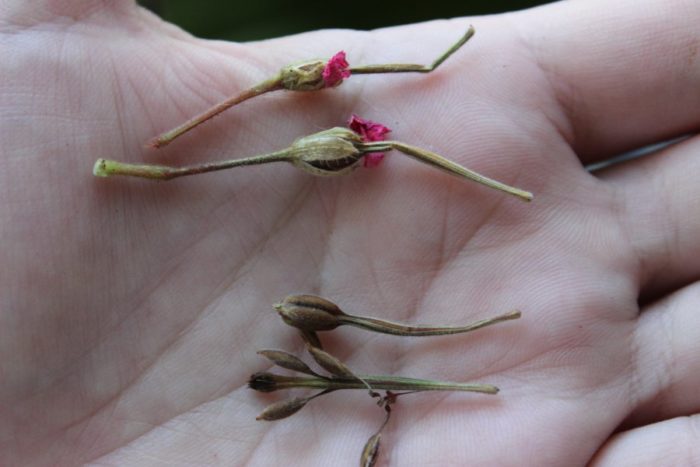
Geranium in the garden is easier to propagate with seeds purchased or obtained from the parent bush. However, the method is quite lengthy. After flowering, beak-like fruits remain on the plant. They are not ripped off until the end of ripening and drying.
There are seeds inside the dried fruit. To grow a new plant out of them, the following rules are followed:
- The seeds are planted in a moist mixture of sand, peat (1 part each) and sod land (2 parts). They are simply laid out on the surface with a step of 5 cm and covered with a layer of sand 0.5 cm thick.
- To facilitate pecking of the sprouts, the seeds are rubbed with sandpaper to remove the top dense layer. Also, to increase efficiency, they are kept in a growth accelerator before planting.
- The pallet with the planted seeds is covered with cling film and removed to a warm place. Periodically, the film is opened to ventilate the contents.
- When shoots appear, the film is removed, and the pallet is moved to a cool, bright place.
- The sprouts are watered with a solution of potassium permanganate, trying to prevent moisture drops from falling on the young plant.
- After the appearance of the first leaves, the shoots are transplanted into separate cups after 2 weeks, and on the 45th day the flower is transplanted into a permanent pot.
- When the sixth leaf appears on the stem, pinch the sprout to form a bush.
Propagation by cuttings
Most often, propagation by cuttings is used at home.The method is used in autumn and spring, but in principle, any season is suitable. To do this, cut healthy, undamaged cuttings 70-100 mm long with a sharp knife. The cut is made between the nodes. All leaves, except for a couple of pieces at the very top, are cut off. The stalk is dipped for 5 minutes in a solution to stimulate root formation, which is sold in a specialty store.
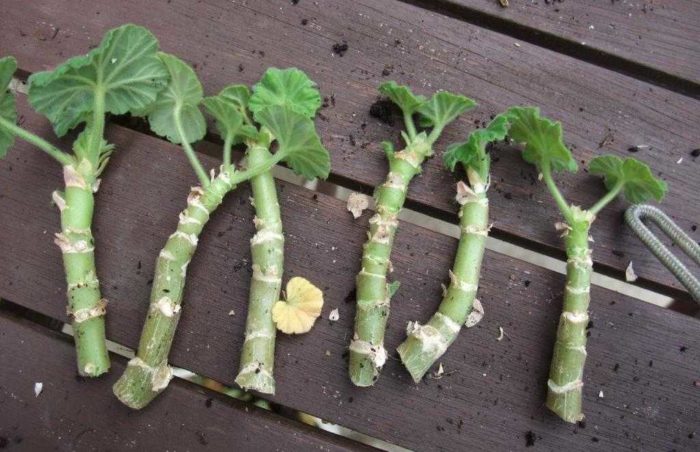
There are several rooting options:
- The stalk is planted in a hole made in a suitable soil.
- After exposure to the root formation enhancer, the shoot is placed in a glass of water, to which 2 crushed activated carbon tablets are added. After the roots appear, the plant is transplanted into the ground. But this technique is not suitable for royal geraniums, because in the water it will start to rot.
- Wet soil is poured into the bag, cuts are made and a cutting is planted. The method is good in that it retains moisture in the upper part, but does not allow the roots to rot.
- It is convenient to plant many sprouts in special mini greenhouses. This is a large, flat container with a lid that has ventilation holes. The cuttings are planted in moistened soil and covered with a transparent lid.
Reproduction by dividing the bush
If new shoots grow from the roots, then they are separated and transplanted into separate pots.
It is important to separate the "children" so that they retain a part of the root system. In principle, the requirements for the soil for planting new shoots are no different from the conditions for growing an adult plant

Pelargonium transplant
The transplant greatly affects the health of the flower. It is best carried out in early spring. This procedure is performed most often to increase the space for the flower. Thus, a pot with a diameter of 1.5-2 cm larger than the previous one is better suited for transplanting. Planting pelargonium requires accuracy and care, so you should be careful.
Important! At the bottom of the new pot, you need to put expanded clay so that excess moisture does not remain, but evaporates. Homemade ampelous pelargonium is becoming one of the favorite flowers for housewives, not only because it blooms very beautifully, but also because of its undemanding care
In order for a flower to always remain lush and beautiful, you just need to be careful and follow simple, but important rules for geraniums.
Homemade ampelous pelargonium is becoming one of the favorite flowers for housewives, not only because it blooms very beautifully, but also because of its undemanding care. In order for a flower to always remain lush and beautiful, you just need to be careful and follow simple but important rules for geraniums.
Geranium species

Answering the question of how to care for geraniums at home, I would like to consider its types and find out if there are any differences in care. In general, for indoor maintenance, there are two options for geraniums: bush and ampelous. The first one needs a spacious pot, the second one needs a pots. In care, both types are unpretentious.
The most common geraniums are:
- Royal is a beautiful plant, it differs from the usual geranium in leaves and inflorescences. Almost odorless, blooms for a long time, in caps, but not as long as other species. When grown from seeds or stalks, flowering begins in the second year.
- Zonal pelargonium is the most common geranium we are used to. The abundant flowering and beauty of the flowers brought the plant such popularity. Some do not like to keep such geraniums at home, as a characteristic bitter smell spreads from it through the apartment.
- Fragrant geranium is a very interesting plant. It is planted at home not so much for flowering (the flowers are not so remarkable), but for the scent. Today there are varieties with aromas of nutmeg, apple, citrus, rose.
- Meadow - cultivation is possible both in the garden and in an apartment in a pot.
- Tulip and peony geraniums are interesting flowering plants that are great both for growing in a garden and in a pot.
For any type of color, they differ in their variety.It is not recommended to put pots with geraniums of different colors on the same windowsill, as the plant quickly becomes pollinated, and as a result, the color changes. For example, you put snow-white and scarlet geraniums next to it, then both will become simply pink. Next, we propose to find out what should be the care of geraniums in a pot. We will consider the rules for watering, pruning, transplanting. You will also find out why the plant does not bloom and why its leaves may turn yellow and fall off.
Diseases and pests of geranium
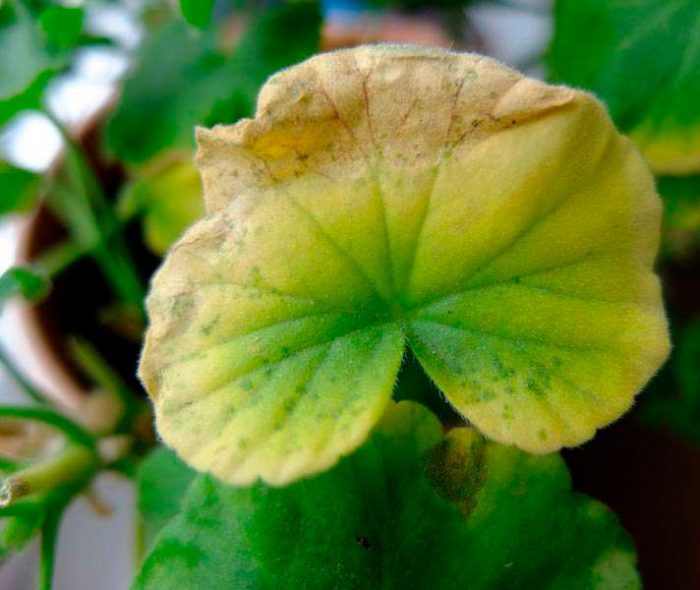
Diseases
Geranium is highly resistant to disease. However, she can still get sick, and most often this is due to improper care.
Sometimes it happens that the leg of a young bush turns black (black rot). It is impossible to cure a diseased plant. Therefore, it is burned, and the substrate is disinfected or thrown away. In order to prevent the development of root, black and gray rot, do not allow moisture to stagnate in the substrate.
Pests
Whiteflies, ticks or aphids can settle on the flower
If you find aphids or ticks on the bush, then rinse its foliage with an infusion of tobacco or chamomile mixed with green soap as soon as possible, paying special attention to the seamy surface of the plates. Wait two to three hours and rinse the bush with clean water
To save geranium from whitefly, it should be sprayed alternately with solutions of the following drugs: Confidor, Fufanon, Bison and Actellik. The fact is that it is rather difficult to exterminate adults and larvae of the whitefly.
Geranium leaves turn yellow, turn red, dry, curl ... Diseases and pests of pelargonium
Why does geranium turn yellow
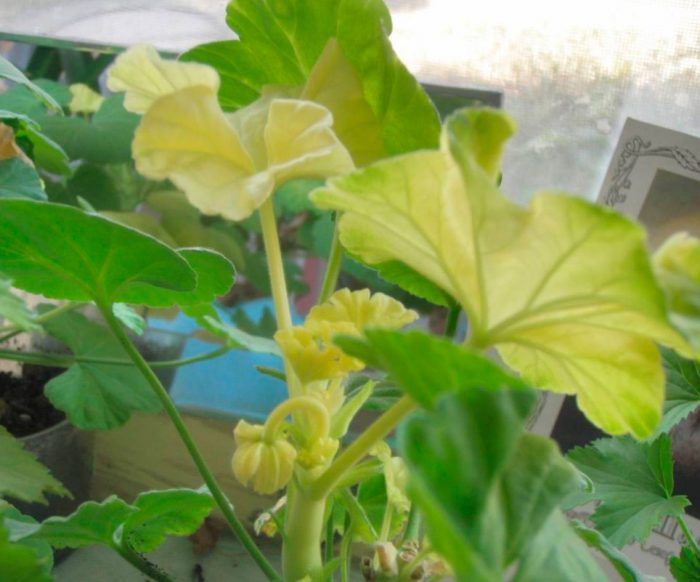
Yellowing of the foliage of pelargonium can be observed for several reasons:
- yellowing and drying of the edges of the leaf plates means that the bush needs watering;
- if the foliage turns yellow, and the bush itself is sluggish, it means that liquid constantly stagnates in the soil mixture;
- yellowing of the bush and dropping of the lower foliage is associated with poor lighting;
- the root system is cramped in the pot;
- the bush was recently transplanted or moved to another location.
Why geraniums do not bloom
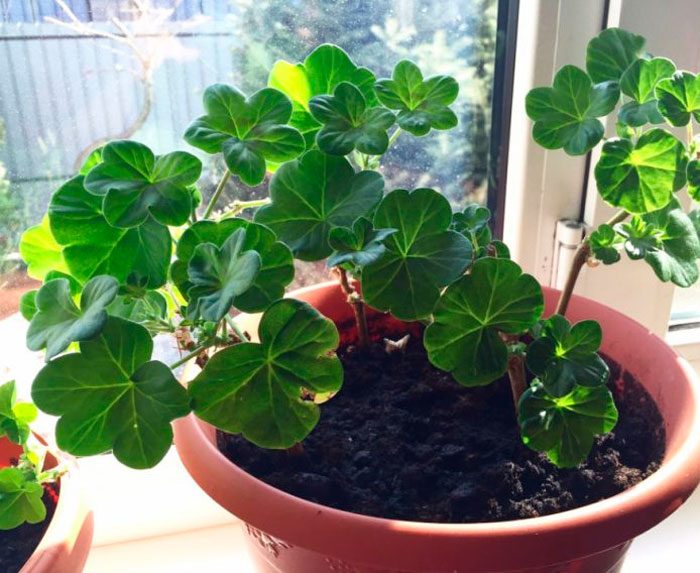
As a rule, pelargonium refuses to bloom for the following reasons:
- the room is cold or the bush lacks sunlight, to correct the situation, supplement it with fluorescent lamps;
- there are too many nutrients in the substrate (it is recommended to purchase a special soil mixture for geraniums for the flower, and you can also make it yourself according to a special recipe, which is described above);
- overly large pot;
- the bush is pruned irregularly (thanks to pruning, geranium grows lush and blooms profusely);
- untimely feeding.
Why doesn't geranium bloom ?!
Why does geranium dry
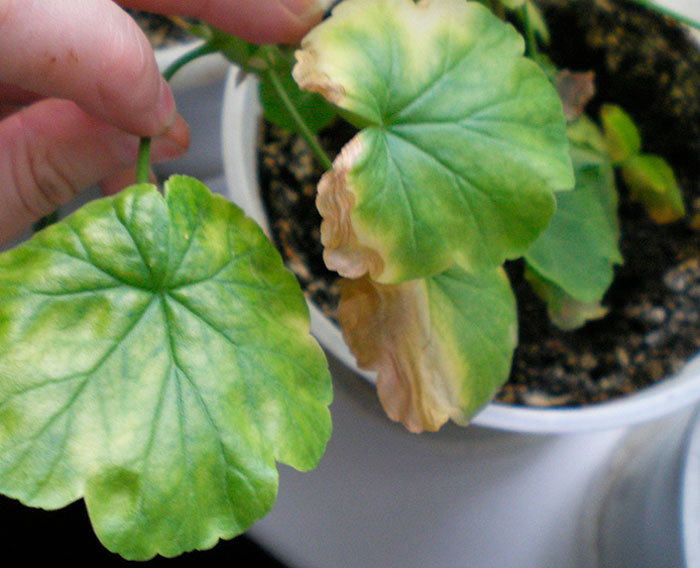
If only the tips of the leaf plates dry up in the bush, this means that it needs watering. Rust can cause the bush to dry out. When this fungal disease is affected, brownish-red specks first form on the foliage, and then it dries up and flies around. Treat the bush with a Bordeaux mixture solution (5%). Instead, you can carry out two treatments with Fitosporin with a break of 1-1.5 weeks.
Formation of a geranium bush in summer and winter
Pruning has many benefits. This is not a difficult process that even a novice amateur - a florist can handle. I must say that all types of geraniums grow at different rates. But they all have a common quality: as the trunk grows, the lower leaves begin to wither and fall off. Greenery is preserved only at the top of the stem, where flower buds are formed. Therefore, timely pruning is so important, otherwise, the plant will be lanky and shapeless. To prevent this, geraniums are pruned after flowering.
What does pruning at home give:
- the formation of a large number of new shoots;
- the density and splendor of the crown;
- abundant bud formation.
There is no need to be afraid of a deep haircut, because there are dormant buds on the bare stems.In winter, it is better not to cut the plant, since it is in a dormant period, and all internal processes are weakened. Shoots that are pruned during this period are not suitable for rooting. Shoots cut during the growing season, when the flower begins to actively develop and grow, are suitable for reproduction.

